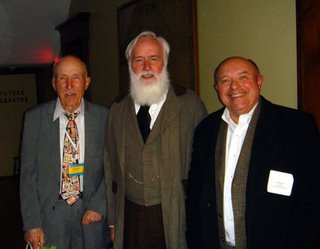 Abraham Lincoln died on a Good Friday, April 14, 1865. An article in the New York Times today discusses this coincidence. Most 19th-century Christians hestitated to link the life of Jesus to any mortal, but in Lincoln's case, many speakers made that connection. Through years of trial and sacrifice, the President stood for Union, and now on the eve of victory, he had died for his people.
Abraham Lincoln died on a Good Friday, April 14, 1865. An article in the New York Times today discusses this coincidence. Most 19th-century Christians hestitated to link the life of Jesus to any mortal, but in Lincoln's case, many speakers made that connection. Through years of trial and sacrifice, the President stood for Union, and now on the eve of victory, he had died for his people.Walt Whitman wrote two poems on the death of Lincoln: one a sentimental lyric, "O Captain, My Captain," and the other "When Lilacs Last in the Dooryard Bloom'd," one of the great elegiac poems in English. Stanza 5 depicts the journey of the funeral train toward Springfield:
Over the breast of the spring, the land, amid cities,
Amid lanes and through old woods, where lately the violets peep'd from the ground, spotting the gray debris,
Amid the grass in the fields each side of the lanes, passing the endless grass,
Passing the yellow-spear'd wheat, every grain from its shroud in the dark-brown fields uprisen,
Passing the apple-tree blows of white and pink in the orchards,
Carrying a corpse to where it shall rest in the grave,
Night and day journeys a coffin.
So a great martyr came home, dying in a season of growth and renewal. From this date on, his life belonged to the ages.
